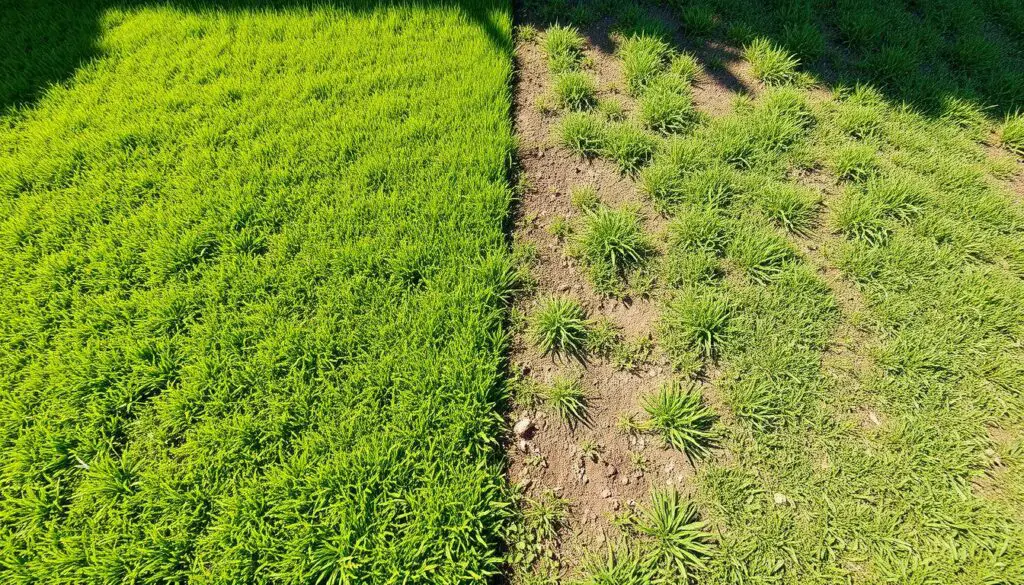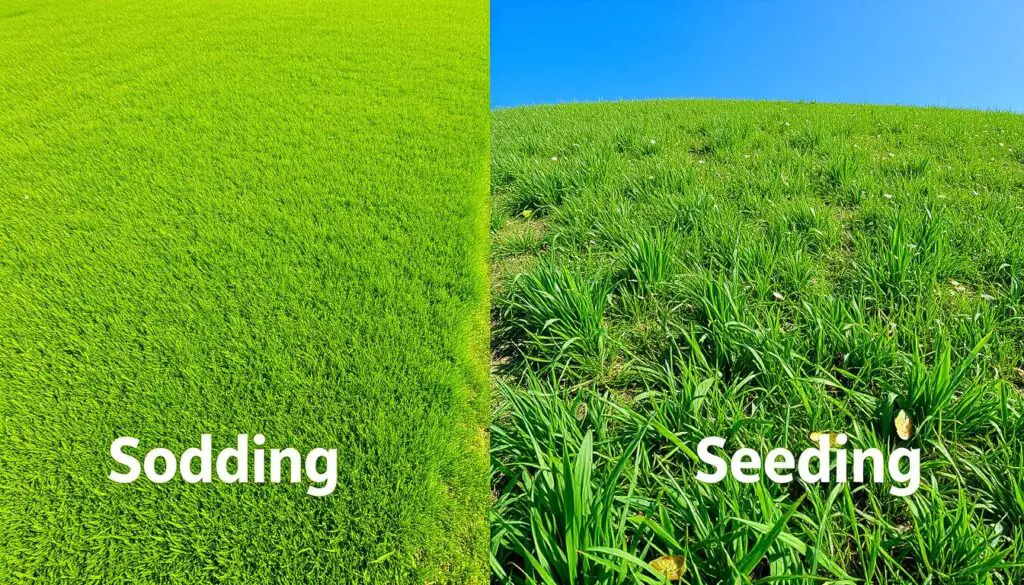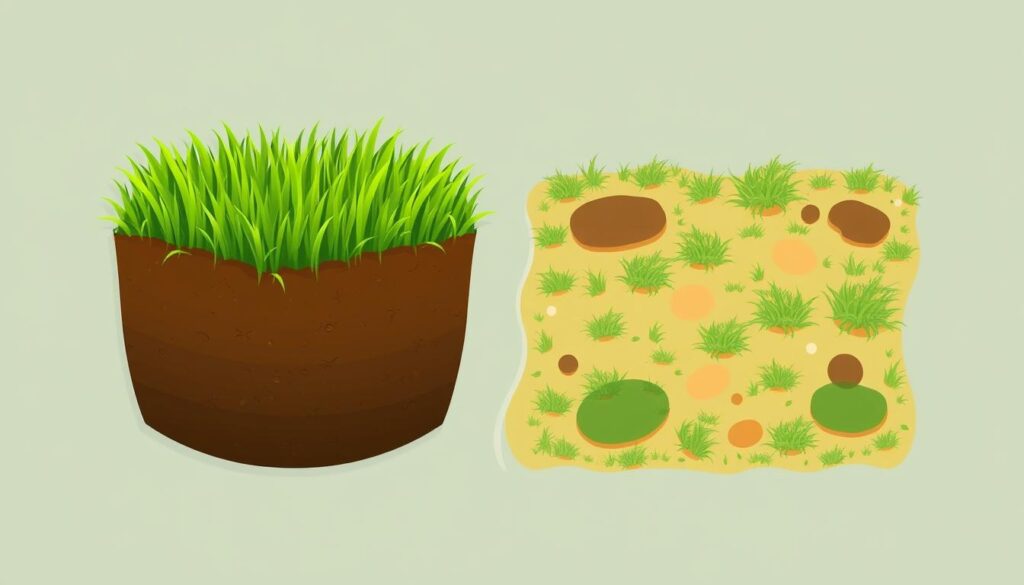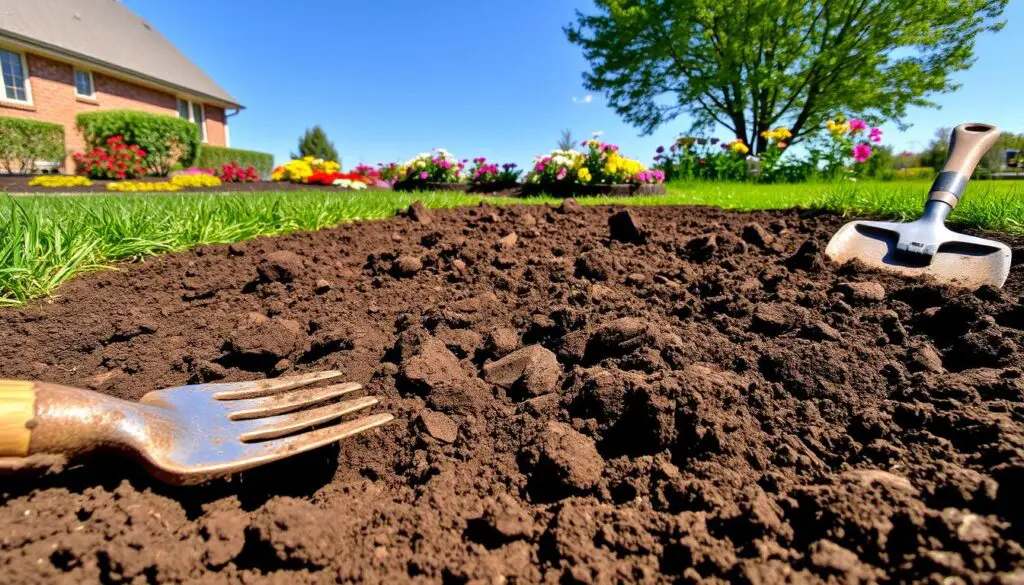How to Establish a New Lawn Seeding vs Sodding

Did you know seeding a lawn can cost between $100 to $500 for materials? Professional seeding might cost $400 to $1,300. On the other hand, sodding a lawn can cost between $1,000 to $2,500 for professional installation. The cost of sod itself is usually between $170 to $380. These costs show how important it is to choose between seeding or sodding for your new lawn.
When starting a new lawn, you have two main options: seeding or sodding. Your choice depends on the area, time, and money you have. Sodding gives you an instant lawn, but seeding is more cost-effective and takes longer to grow.
The main differences are in the installation, durability, lifespan, and environmental impact. Seeding is more affordable but needs more time to grow. Sodding is pricier but gives you a lawn right away.
Key Takeaways
- Seeding is less expensive than sodding when establishing a new lawn.
- Sodding is more expensive but provides instant results compared to seeding.
- Seeding offers more grass species and varieties to choose from compared to sodding.
- Moisture is critical for the young seedlings when seeding a lawn.
- Seeding has a stronger root system development initially and long term.
The Difference Between Seeding vs Sodding
Homeowners have two main choices for a new lawn: seeding or sodding. Both aim for a lush, green space but differ in process and result. Knowing the differences helps you choose wisely based on your needs and budget.
What is Lawn Seeding?
Lawn seeding plants grass seeds directly into the soil. It takes patience, as seeds germinate in 28 days and the lawn grows over seasons. Yet, seeding lets you pick the grass type that fits your climate and taste.
What is Sod Installation?
Sod installation lays down pre-grown grass strips. This gives you an instant, ready-to-use lawn. It’s pricier than seeding but quicker and more reliable for a new lawn.
Choosing between seeding and sodding depends on your budget, project timeline, and property needs. Knowing the pros and cons helps you pick the best for your dream lawn.
“Seeding is a better choice for filling in small bare spots in your lawn, whereas sodding works best for repairing larger bare areas.” – Sam Masser, author of the Mowers Guide
Whether seeding or sodding, proper soil prep, maintenance, and the right grass type are key for a lasting, healthy lawn.
Factors to Consider: Seeding vs Sodding
When you’re starting a new lawn, you have two main choices: seeding or sodding. Each has its own good points and things to think about. Let’s look at the key things to remember when deciding.
Appearance
Sod gives your lawn an instant, grown-up look. It makes your lawn look lush and green right away. But, a seeded lawn might look a bit uneven at first. It takes a few weeks to get to its full look.
With the right care, a seeded lawn can look as good as a sodded one. It just takes a bit of time.
Cost
Sod costs more than grass seed at first. Sod can be up to twice as expensive per square foot. But, it gives you quick results and saves you from a lot of work. Seeding is cheaper, which is great for bigger lawns.
Upkeep
Sodded lawns need a lot of care right away. They need lots of water to grow well. Seeded lawns are easier to take care of at first. They need water and weed control until they grow strong.
Sod might need to be replaced if it doesn’t grow well.
| Factor | Seeding | Sodding |
|---|---|---|
| Appearance | Can appear patchy during establishment | Immediate, mature look |
| Cost | More budget-friendly, specially for bigger areas | Higher upfront cost, but may save time and labor |
| Upkeep | Less demanding during initial growth phase | Requires more immediate attention and care |

“Choosing between seeding and sodding requires carefully weighing the unique benefits and drawbacks of each approach to determine the best fit for your lawn and budget.” – Sam, lawn specialist
Durability of Seeded vs Sodded Lawns
Both seeding and sodding have their own strengths when it comes to creating a new lawn. Seeded lawns might be less durable in the short term, mainly in the first few weeks. This is because seeds are more prone to drying out, disease, and pests. But, once the seeds germinate and roots grow, seeded lawns can become very durable.
Sodded lawns, on the other hand, are more durable right from the start. The mature sod provides immediate coverage and protection. This makes sodded lawns great for those who want a lawn they can use right away.
In the end, both seeded and sodded lawns can be very durable. But, the journey to get there is different. Seeded lawns need more patience and care in the beginning. Sodded lawns, though, start off strong and ready to go.
Key Factors in Lawn Durability
- Grass seed is more susceptible to drying out, disease, and insect damage in the short term compared to established sod.
- Seeded lawns need time for the grass to germinate and establish strong roots, while sodded lawns provide instant coverage and protection.
- Sodded lawns are ready for immediate use and can withstand foot traffic, while seeded lawns require more time before they are ready for heavy use.
- Seeded lawns may show uneven growth patterns initially, leading to a less uniform appearance, while sodded lawns provide an instant, uniform transformation.
- Both seeded and sodded lawns can develop strong, durable root systems over time, but the path to reaching that level of resilience differs.
Choosing between seeding and sodding depends on your timeline, budget, and how soon you want to see results. It’s about finding the right balance between immediate satisfaction and long-term durability.
Seeding vs Sodding: Installation Process
Creating a new lawn is key to a welcoming outdoor space. Seeding and sodding are two main ways to do this. Each method has its own steps and benefits.
Lawn Seeding Installation
Seeding a lawn means planting grass seeds in the soil. It takes time and effort. Seeds need watering and care until they grow strong roots.
Grass seed costs between $0.04 to $0.20 per square foot. This is cheaper than sod.
- Start by preparing the soil with tilling and leveling.
- Spread the seeds evenly, following the grass type’s seeding rate.
- Rake the seeds into the soil gently.
- Keep the soil moist until the seeds germinate, which takes 10 to 12 weeks.
- Mow the lawn when it’s 3 to 4 inches tall, gradually increasing the height.
Sod Installation Steps
Sod gives you an instant lawn. It’s a pre-grown product laid on the soil. This method is quicker but more expensive.
Sod costs $0.35 to $0.85 per square foot. Installation can cost $1,047 to $2,906 more.
- Remove old vegetation, till, and level the soil.
- Place the sod in a staggered pattern, pressing it firmly into the soil.
- Water the sod right away, keeping it moist for 2 to 3 weeks.
- Mow the sod after a week, then regularly maintain it.
Seeding and sodding each have their pros and cons. Your choice depends on time, budget, and preference. Knowing the steps for each helps you decide what’s best for your lawn.
Lifespan: How Long Do Seeded and Sodded Lawns Last?
Both seeding and sodding have their benefits for a new lawn. But, how long will they last? Let’s explore the lifespan of seeded and sodded lawns.
Seeded lawns can last for many years. The grass grows from seed and develops strong roots. Grass seed can stay viable for 2 to 5 years, with germination rates dropping over time. With the right care, a seeded lawn can last a decade or more.
Sodded lawns might not last as long. The pre-grown sod may not have time to develop deep roots before being installed. But, with proper care, a sodded lawn can also thrive for years. It’s important to give the new sod time and attention to establish well.
Both seeded and sodded lawns can bring beauty and enjoyment for years. Quality grass and responsible care are key. Understanding the differences in seeded lawn lifespan and sodded lawn lifespan helps you choose the best option for your landscape.

“Fresh seed maximizes the chances of establishing a robust lawn quickly. Using fresh grass seed ensures higher germination rates, leading to a denser, more uniform lawn.” – Sam, mower professional
Choosing to seed or sod affects your lawn’s longevity and maturity. Factors like grass type and maintenance play a big role. By knowing these, you can create a beautiful outdoor space that will last for years.
Environmental Impact: Seeding vs Sodding
Choosing between seeding and sodding for a new lawn is key. Both have their pros and cons, affecting lawn water usage and carbon footprint.
Water Usage
Seeding needs less water at first compared to sodding. Sod, being pre-grown, needs more water to settle in. But, seeded lawns might need more water later to stay healthy.
Carbon Footprint
Seeding is better for the environment than sodding. It has less transportation emissions since seed is lighter. Growing and harvesting sod also has a bigger carbon footprint than seeding.
| Criteria | Seeding | Sodding |
|---|---|---|
| Water Usage | Lower during establishment, higher for ongoing maintenance | Higher during establishment, lower for ongoing maintenance |
| Carbon Footprint | Lower due to reduced transportation and production emissions | Higher due to the energy-intensive process of growing and harvesting sod |
Choosing between seeding and sodding depends on your budget, time, and preferences. Both have benefits. Thinking about the environmental impact helps you choose wisely.
“Seeding is often considered more environmentally friendly than sodding as it requires less water during establishment and has fewer associated emissions.”
Choosing the Right Grass Type for Your Climate
Starting a healthy lawn begins with picking the right grass for your area. Each type of grass needs different things to grow well. Think about your climate’s temperature, rain, and soil to pick the best grass.
In the North, cool-season grasses like Kentucky bluegrass, perennial ryegrass, and tall fescue do well. The South prefers warm-season grasses like St. Augustinegrass, Bermudagrass, centipedegrass, and zoysiagrass for their heat tolerance.
The Transition Zone has a mix of grasses. It includes tall fescue, Bermudagrass, zoysiagrass, and Kentucky bluegrass. For tough spots, buffalograss and fine-leaf fescues are great.
When picking your grass type, think about climate-appropriate grass and turf grass needs. The right grass type for your lawn establishment means a healthy, green lawn that lasts.

“Choosing the right grass type is key for a successful lawn establishment. A climate-appropriate grass leads to a lush, lasting turf grass in your area.”
Preparing the Soil for a New Lawn
Getting your soil ready is crucial for a lush, healthy lawn. Whether you choose to seed or sod, knowing your soil is key. It affects your lawn’s success in the long run.
Soil Testing
Start by testing your soil. This tells you about pH levels, nutrients, and soil health. With this info, you can choose the right amendments for your grass.
Amending the Soil
After testing, amend your soil as needed. Add compost to improve structure and water retention. Adjust pH levels with limestone or sulfur for the best grass growth.
Don’t forget about drainage. If your soil holds too much water, add sand or aerate. This ensures roots get the oxygen they need.
Soil preparation is the first step to a beautiful lawn. The work you do now will pay off in the future. Your lawn will thank you for it.

“Healthy soil is the foundation for a thriving lawn. Taking the time to test and amend your soil can make all the difference in the world.”
Maintaining a Healthy Lawn After Establishment
After I’ve set up my new lawn, whether by seeding or sodding, it’s key to keep it healthy. This means regular mowing, watering, fertilizing, aerating, and controlling weeds. The care needed can change based on the grass type, climate, and other factors. But with proper care, my lawn will stay lush and green for many years.
Mowing regularly is vital for a great-looking lawn. I’ll mow at the right height for my grass, usually around 3 inches. This helps it grow well and stay dense. Also, watering often, during dry times, keeps the grass healthy and prevents it from getting stressed or dormant.
Using the right fertilizer at the right times is also important. It gives my grass the nutrients it needs to grow strong. Aeration, which makes small holes in the soil, helps with water and air flow. This lets the roots grow stronger.
Lastly, controlling weeds is crucial for a healthy lawn. I’ll remove weeds by hand or use selective herbicides when needed. By following these lawn care tips, my new lawn will stay beautiful and inviting for years.
FAQ
What is the difference between seeding and sodding a lawn?
What are the key factors to consider when choosing between seeding and sodding?
Which option is more durable, seeding or sodding?
What is the installation process for seeding and sodding a lawn?
How long do seeded and sodded lawns typically last?
What is the environmental impact of seeding versus sodding?
How do I choose the right grass type for my climate?
How do I prepare the soil for a new lawn?
How do I maintain a healthy lawn after it’s been established?
Source Links
- https://www.groundsguys.com/blog/2015/june/seed-vs-sod-which-one-to-choose-/
- https://www.homeadvisor.com/r/sod-vs-seed/
- https://extension.umn.edu/lawn-care/seeding-and-sodding-home-lawns
- https://lawnlove.com/blog/grass-seed-vs-sod/
- https://genesissodfarms.com/sod-vs-seed/
- https://www.saratogasod.com/tips-resources/sod-vs-seed/
- https://www.terra-lawn-care.com/does-grass-seed-expire-lawn-care-viability-tips/
- https://cedruslandscapedesign.ca/should-you-buy-seed-or-sod/
- https://www.bhg.com/gardening/yard/lawn-care/how-to-choose-the-best-type-of-grass-for-your-lawn/
- https://soilutions.net/blogs/lawn-care/starting-a-new-lawn-from-seed-or-sod
- https://organiclawnsbylunseth.com/sodding-a-lawn/

